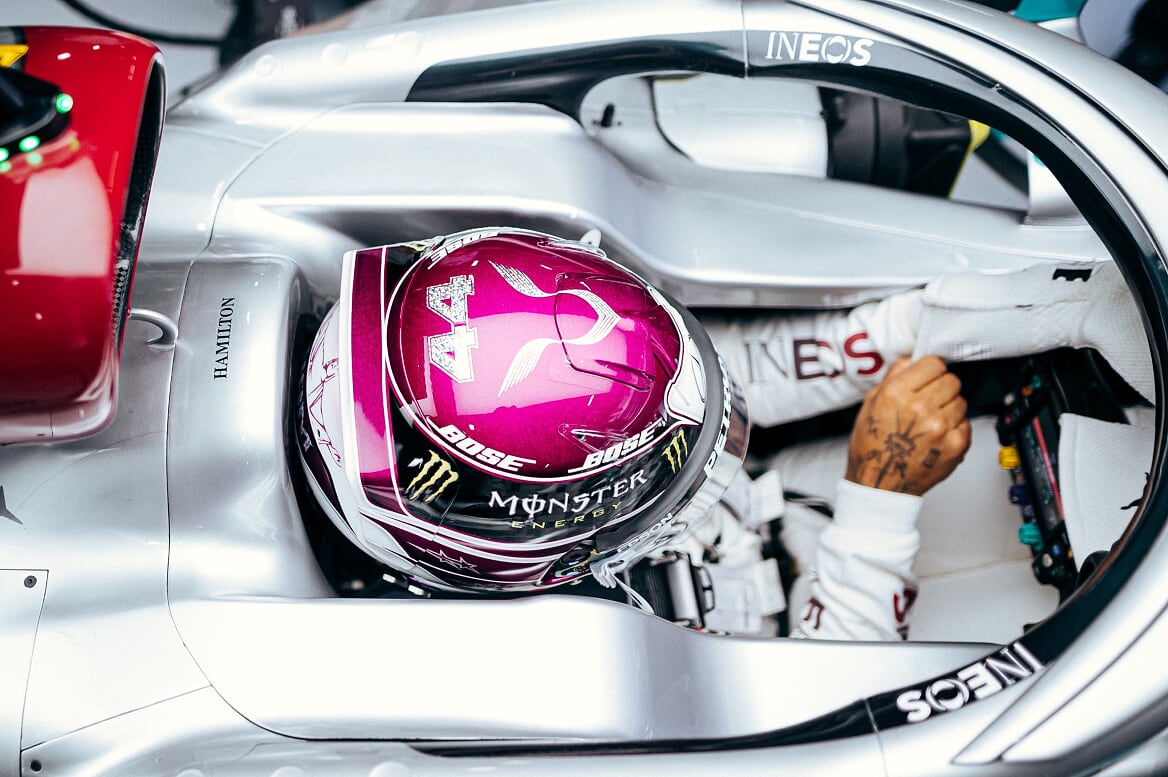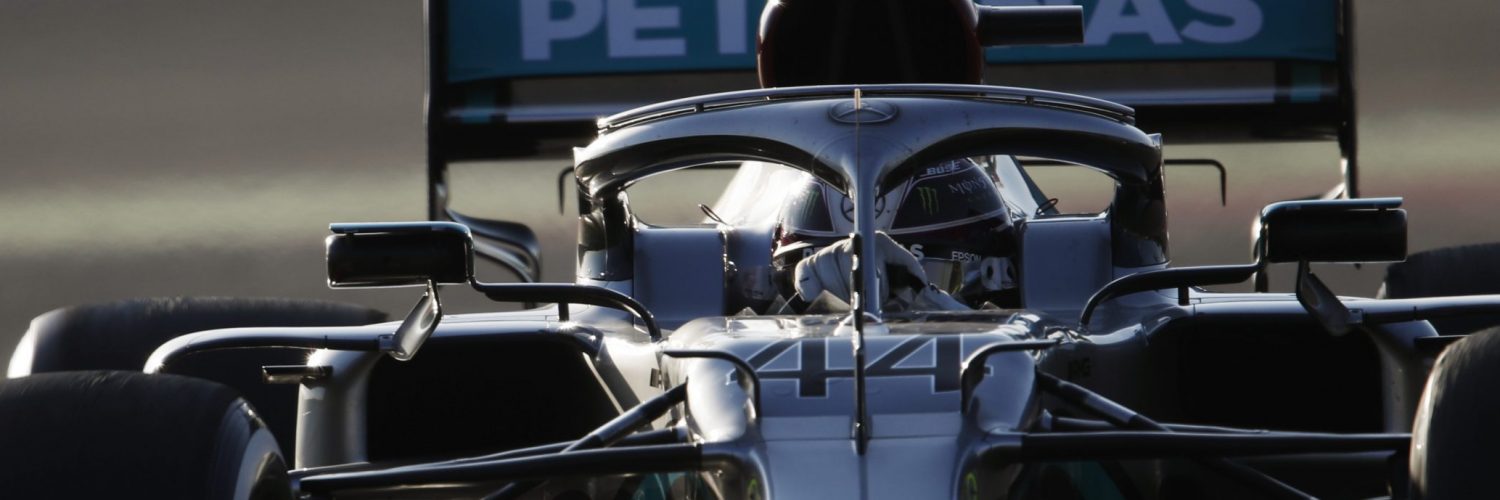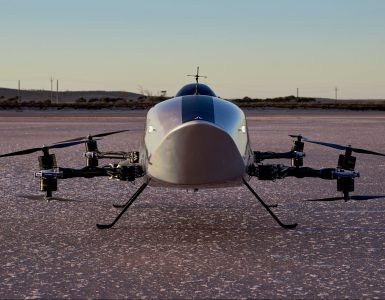Necessity, they say is the mother of invention. But innovation in F1 is often split between the truly imaginative new idea or workarounds to restrictive technical rules. Driven by either necessity, F1 never fails to impress with the stream of new design ideas.
Mercedes proved this to be the case on the second day of the first Barcelona test. As Lewis Hamilton set off down the long main straight at the Barcelona circuit, he could be seen to pull the steering wheel backwards by a few centimetres.
This rather alarming movement was not the result of some slack in the steering the column, but the means for a wholly new method of steering adjustment. It was visible that the front wheels steering inwards slightly, when the steering wheel was pulled, altering the car’s “toe” geometry. Mercedes termed this DAS, Dual Axis Steering, which now has their rivals and the media scurrying off to understand what it does and how.
The Ackerman advantage
Steering on an F1 car is much like most road cars, the driver steers via the steering wheel. This is connected to the steering column that runs down the footwell area to a steering rack. For accuracy Rack and pinion steering is used, a small pinion gear is connected to the column and the geared rack then connects to the track rods leading out to the steer the front wheels.
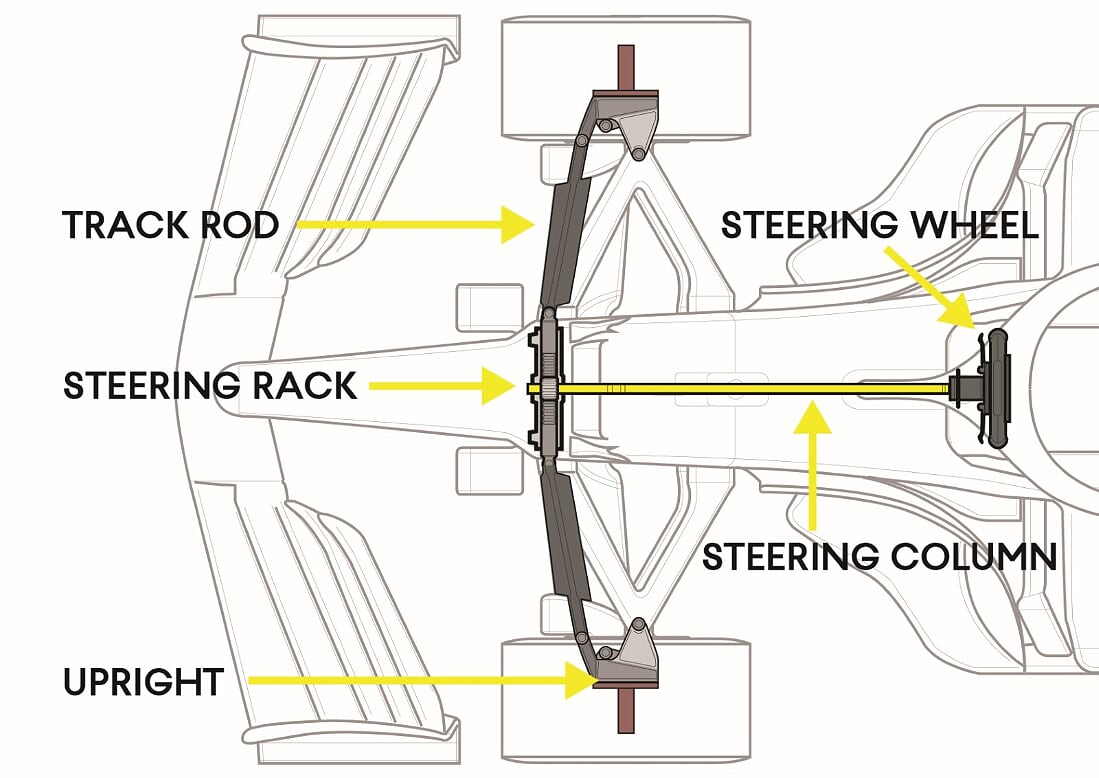
With either shims or turnbuckles, the track rods allow the steering toe angle to be adjusted. Toe angle is the direction the wheels point at, relative to each other, in plan view. For road cars this often called ‘tracking’, on the road this is less to do with handling and affects tyre wear. When your tracking is off, the tyres wear more on the inside of the tread than the outside.
Typically, a race car has a small degree of toe out, that is the wheels point slightly away from each other. This may only be an offset of a few mm at the leading edge of the wheel rim, but this helps the car enter a corner. While this toe-out helps in turns, on the straights the front tyres are then turned outwards to the direction of travel and this scrubs the tyre along the track surface. This creates friction between the track and tyre, thus reducing speed and heating up the tyre. Such a set up compromise has always been accepted with racing cars, although there are a few solutions to ease the problem of toe that suits straight and/or corners.
It is possible to alter toe with steering angle, by means of Ackerman geometry. By altering the geometry of the steering axis relative to the track rod pivot, so that when turning the inner wheel can turn more/less than the outer wheel. This creates a relationship of toe angle versus steering angle, known as the toe curve.
Even with Ackerman the tracking of the front wheels is fixed, that is to say the toe curve of the front wheels is fixed, if you have 2mm of toe in a straight line, then you will always have 2mm of toe in a straight line.
We call it DAS – Dual Axis Steering! 🛠 James has an update on today's hot topic of #F1Testing… 👇 pic.twitter.com/kKDHJqzutK
— Mercedes-AMG PETRONAS F1 Team (@MercedesAMGF1) February 20, 2020
DAS
For the most part a compromise in toe geometry is not a problem for race engineers, in F1 Mercedes found there was performance to be gained from having the ability to switch from one toe curve to another. So, what are Mercedes doing?
When the steering wheel is pulled, it’s clear to see the front wheel toe inwards slightly, thus going from toe-out, to less toe-out, potentially parallel or even toe-in steering. With this we can conclude that DAS is there to alter Toe. There by Mercedes have the potential to run the beneficial toe out for corners and parallel/toe in for the straights.
Quite how Mercedes do this is still a secret, the huge interest in this system has quickly drawn a number of potential solutions. At first, the obvious means might have been moving the steering rack fore and aft, via slotted mounts or an eccentric mounting. The steering column movement would have shifted the rack enough to alter toe angle. But looking closer at the exposed end of the steering rack near the nose of the car, shows there is no scope for such movement, so a change in rack length must be achieved in another way.
There could be linkages between the column and rack ends to alter the racks effective width, looking at the space around the rack on the W11, there seems little scope for this sort of solution.
What is more likely is a split rack and pinion. Within the rack body there could be a sliding rack for each wheel, then a split pinion gear for each rack can be offset with a helical internal connection to the column. As the column is pulled back, the helical connection contra-rotates the two pinions, moving the racks apart and narrowing the effective rack width.
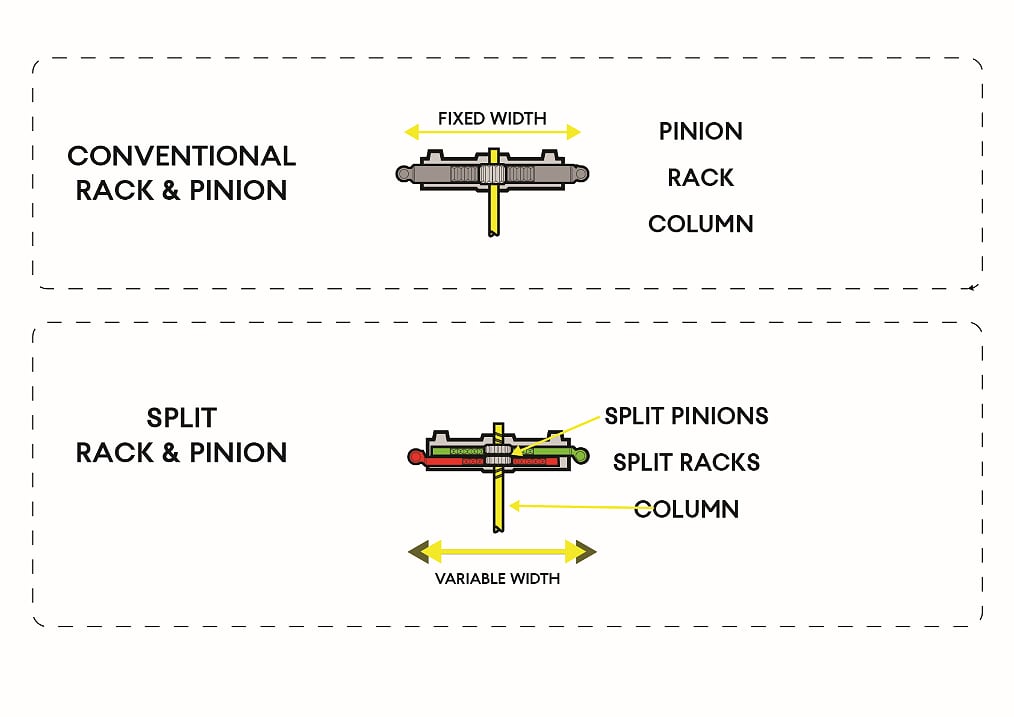 Animations have appeared on the internet showing just such a system. This seems far more plausible than other solutions. Usefully the whole mechanism is contained within a nearly conventional steering rack, useful if the system is not to be run at every race.
Animations have appeared on the internet showing just such a system. This seems far more plausible than other solutions. Usefully the whole mechanism is contained within a nearly conventional steering rack, useful if the system is not to be run at every race.
So, if Mercedes are able to make the rack width effectively narrow with the steering wheel being pulled back what are they gaining? Its most likely that the DAS effect is creating parallel steering on the straights, leaving toe out for the corners. Having no toe angle on the straights mean the tyres will point in the same direction as the car is travelling.
There are several effects here that could be beneficial; firstly, the tyres will not create the friction by running at angle to the direction of travel, this could boost top speed slightly, something Mercedes struggled with against Ferrari last year. Also, the wheel being parallel to the airflow could have an aero effect, either reducing drag directly or altering airflow to stall aerodynamics downstream to further boost top speed. With current F1 cars running Pushrod-On-Upright (POU) suspension set ups, the change in steering could alter ride height, lifting to the nose slightly on the straights to reduce rake and cut drag.
All of these effects could be advantage but would be very small gains for a huge technical investment. What’s more most of these gains could be achieved with Ackerman geometry, again not requiring the cost and complexity of DAS. Thus, we have to regard these gains as secondary advantages to the system
So, the gain must be in being able to decide when to engage the change the in Toe with DAS. For this the main win would be the first gain in reduction in friction between steered tyre and track. But, not for the potential speed gain, but the reduction in friction from the tyres slipping along the track causing the tyre to get hotter. Current F1 performance is hugely affected by tyre management, being able to cool the front tyres on demand would be a primary gain in race situations, something not possible with Ackerman or any other solution, as any on track adjustable brake duct heating solution would be illegal.
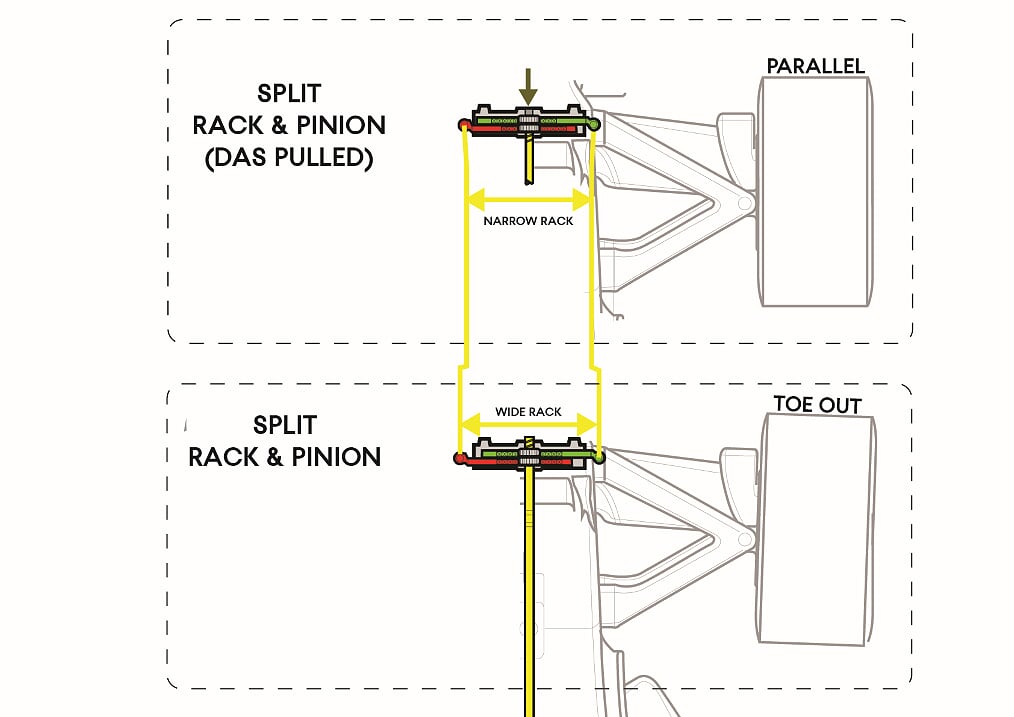
So, the potential scenario would be that tracks which are critical for high front tyre temperatures would see DAS used to cool the tyres on the straights. This might not necessary in qualifying, but in the race, controlling the tyre temperatures during a stint would give an advantage over its rivals. In races where over heating front tyres wouldn’t be an issue, a simpler, lighter and potentially more reliable steering rack could be raced.
If this is the real situation then DAS doesn’t gain overall performance, i.e. its of little use in qualifying, but the gain for race laptimes and strategy would be more significant. But while of real benefit, this isn’t a silver bullet for every team and situation, like for example the double diffuser.
Is DAS Legal?
As the sight of the driver moving the steering wheel backwards and forwards in a race is quite alarming, the first reaction is to question the legality of such a system. Something so weird must be illegal, right? Given the time, over a year for Mercedes to run this development, shows that they have thought carefully about its legality and this has been with the FIA’s acknowledgement.
Firstly, the system can be considered legal as it’s the steering system. The steering section in the FIA technical regulations is quite simple, as few innovations have occurred in the steering system for years. So, there are no sections to outright ban DAS in the rules.
Much tighter regulations affect the suspension, but this is a separate system and thus not the regulations to which DAS has to be measured by. There might be an argument that the change in steering angle also changes suspension geometry and/or aerodynamics, but these are secondary effects, simply steering any race car alters the suspension and aero, so no argument can be pointed at it from this point of view.
There is a potential argument around Parc Fermé rules, that the car has to race with the same set up as the car qualified in. As it stands toe angle is not a measured or declared parameter for Parc Fermé, but it might be argued that using DAS in the race is a change in set up from qualifying. It will need a protest from a team to raise this point to the race stewards, who are the measure of a car’s legality over a race weekend.
Safety might be one line attack for rivals, unless there is a on track problem with DAS that the mechanism locks or fails, this shouldn’t be an issue. There is no question that being in one toe set up or another would in itself be dangerous, so simply using the system is itself not a safety factor.
One other minor legal point might be the steering wheel position itself relative to the Halo, the wheel must sit below the top hoop of the Halo, moving the wheel when engaging DAS might change that, but this would be a minor point to raise if protested.
As it stands the FIA declare that DAS is legal and only during a race weekend can that be argued, we will have to see what the teams do in Melbourne. Regardless, by the end of the year, the system will be outlawed. Having had sight of the Mercedes system for over a year, rules for 2021 have already been changed for 2021. With the cat out of the bag, so to speak, teams may still look at these revised regulations and see if there is scope to come up with something similar but legal within the new framework.
PLAYING CATCH UP
If teams can’t protest DAS, then can they copy it? Well firstly they have to understand and measure the benefit, would they gain from front tyre management in the race? If they do, then there the design of the system. Again, a moving rack or a split/sliding rack solution needs to be designed, as teams already design their own racks this would be an accessible task for a rival to focus on. If the solution is the split rack, if the overall assembly isn’t much larger than the current rack, then this seems a feasible project to introduce mid-season, given enough rig testing has been completed with the hardware beforehand.
Considering the development load for 2020 and ahead of 2021’s major rule changes, not many teams will want to devote the resources to just such a project. With tyre management being a key deciding factor between the top three teams in race situations, it wouldn’t be a surprise is Ferrari and Red Bull looked at introducing a DAS style tyre management system mid-season. Outside of F1, the unique restrictions in the regulations and the peculiar demand on race tyre management, suggests that other race series wouldn’t gain so much from DAS.
